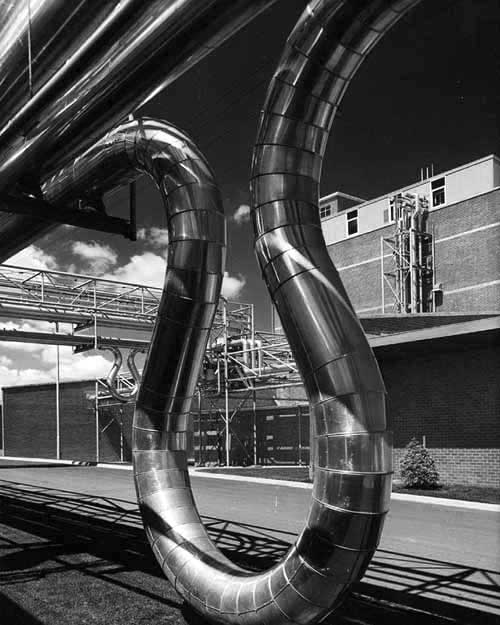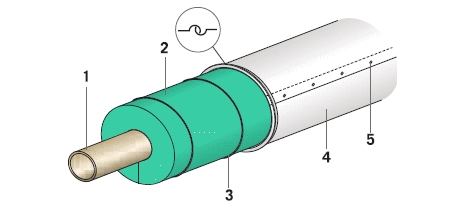Mechanical Insulation – Insulation of Piping
Piping plays a central role in many industrial processes in chemical or petrochemical installations such as power plants, as it connects core components such as appliances, columns, vessels, boilers, turbines etc. with one another and facilitates the flow of materials and energy.
To guarantee a correct process cycle, the condition of the media within the pipes must remain within the set limitations (e.g. temperature, viscosity, pressure, etc.).
In addition to the correct isometric construction and fastening of the piping, the piping insulation also has an important function. It must ensure that heat loss are effectively reduced and that the installation continues to operate economically and functionally on a permanent basis. This is the only way to guarantee the maximum efficiency of the process cycle throughout the design service life without losses as a result of faults.

Requirements for industrial piping
The basic efficiency and productivity factors of piping for the processing industry include: energy efficiency, dependability and reliability under different conditions, functionality of the process control, appropriate support structure suitable for the operating environment, as well as mechanical durability. The thermal insulation of piping plays a significant role in fulfilling these requirements.
Thermal insulation
The functions of proper thermal insulation for piping include:
- Reduction of heat losses (cost savings)
- Reduction of CO2 emissions
- Frost protection
- Process control: ensuring the stability of the process temperature
- Noise reduction
- Condensation prevention
- Personnel protection against high temperatures
Applicable standards – A few examples:
- NACE SP0198 (Control of corrosion under thermal insulation and fireproofing materials – a systems approach)
- MICA (National Commercial & Industrial Insulation Standards)
- DIN 4140 (Insulation works on technical industrial plants and in technical facility equipment)
- AGI Q101 (Insulation works on power plant components)
- CINI-Manual “Insulation for industries”
- BS 5970 (Code of practice for the thermal insulation of pipework, ductwork, associated equipment and other industrial installations)
Minimum pipe insulation thickness
| Fluid Operating Temperature Range and Usage (°F) | Insulation Conductivity | |
| Conductivity Btu · in. /(h · ft2 · °F)b | Mean Rating Temperature, °F | |
| > 350 | 0.32 – 0.34 | 250 |
| 251 – 350 | 0.29 – 0.32 | 200 |
| 201 – 250 | 0.27 – 0.30 | 150 |
| 141 – 200 | 0.25 – 0.29 | 125 |
| 105 – 140 | 0.21 – 0.28 | 100 |
| 40 – 60 | 0.21 – 0.27 | 75 |
| < 40 | 0.20 – 0.26 | 75 |
| Nominal Pipe or Tube Size (inches) | ||||
| < 1 | 1 to < 1-1/2 | 1-1/2 to < 4 | 4 to < 8 | ≥ 8 |
| 4.5 | 5.0 | 5.0 | 5.0 | 5.0 |
| 3.0 | 4.0 | 4.5 | 4.5 | 4.5 |
| 2.5 | 2.5 | 2.5 | 3.0 | 3.0 |
| 1.5 | 1.5 | 2.0 | 2.0 | 2.0 |
| 1.0 | 1.0 | 1.5 | 1.5 | 1.5 |
| 0.5 | 0.5 | 1.0 | 1.0 | 1.0 |
| 0.5 | 1.0 | 1.0 | 1.0 | 1.5 |
a For piping smaller than 1-1/2 inch (38 mm) and located in partitions within conditioned spaces, reduction of these thicknesses by 1 inch (25 mm) shall be permitted (before thickness adjustment required in footnote b) but not to a thickness less than 1 inch (25 mm).
b For insulation outside the stated conductivity range, the minimum thickness (T) shall be determined as follows:
T = r{(1+t/r) K/k-1}
Where:
T = Minimum insulation thickness
r = Actual outside radius of pipe
t = Insulation thickness listed in the table for applicable fluid temperature and pipe size
K = Conductivity of alternate material at mean rating temperature indicated for the applicable fluid temperature (Btu x in/h x ft2 x °F) and
k = The upper value of the conductivity range listed in the table for the applicable fluid temperature
c For direct-buried heating and hot water system piping, reduction of these thicknesses by 1-1/2 inches (38 mm) shall be permitted (before thickness adjustment required in footnote b but not to thicknesses less than 1 inch (25 mm).

1. Pipe 2. Insulation 3. Clamp or binding wire 4. Sheet cladding
5. Sheet-metal screw or rivet
Cladding
Suitable cladding should be applied to protect the insulation from weather influences, mechanical loads and (potentially corrosive) pollution. Selecting the appropriate cladding depens on various factors, such as working loads, wind loads, ambient temperatures and conditions.
When selecting the appropriate cladding, take the following points into account:
- As a general rule, galvanised steel more than aluminium is used indoors due to its mechanical strength, fire resistance and low surface temperature (in comparison to an aluminium cladding).
- In corrosive environments like outdoors on deck where salty water leads to corrision, aluminised steel, stainless steel or glass reinforced polyester is used as cladding. Stainless steel is recommended for use in environments with a fire risk.
- The surface temperature of the cladding is influenced by the material type. The following applies as a general rule: the shinier the surface, the higher the surface temperature.
- To exclude the risk of galvanic corrosion, only use combinations of metals that do not tend to corrode due to their electrochemical potentials.
- For acoustic insulation, a noise absorbent material (Lead layer, polyethyten foil) is installed on the insulation or inside the cladding. To reduce the risk of fire, limit the surface temperatures of the cladding to the maximum operating temperature of the noise absorbent material.
Source: wermac.org
Reference(s):
https://www.wbdg.org, http://www.roxul.com, http://apps.leg.wa.gov/wac
More about Mechanical Insulation
Part 1:
Mechanical Insulation – Types and Materials
Part 2:
Mechanical Insulation – Space Requirements of Insulation







0 comments:
Post a Comment